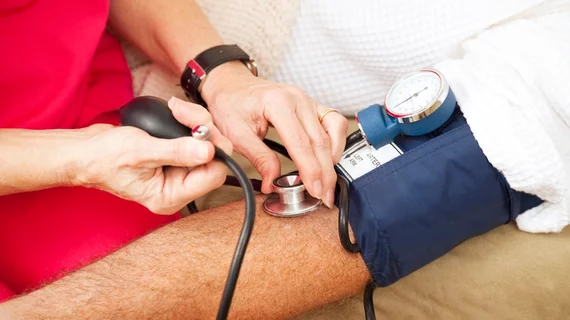Low-risk patients with mild hypertension derived no protective benefit from blood pressure drugs over 5.8 years of follow-up but had an increased risk of adverse effects potentially related to the medication, researchers reported in JAMA Internal Medicine.
The retrospective study should make clinicians think twice before applying guideline recommendations derived from high-risk cohorts to lower-risk patients, wrote authors led by James P. Sheppard, PhD, with the University of Oxford.
The analysis propensity-matched 19,143 treated patients to the same number of untreated patients with mild hypertension—a blood pressure between 140/90 and 159/99 mm Hg confirmed upon three consecutive readings. Sheppard et al. noted this would be considered stage 2 hypertension based on the 2017 update of the U.S. guidelines, which recommend pharmacologic treatment for most people in this category, regardless of other risk factors.
Patients were excluded if they had previous blood pressure treatment before the study, or if they had a history of CVD, atrial fibrillation, diabetes or chronic kidney disease. Thus, the included patients fit the researchers’ standard for low-risk patients, which is an important distinction from previous studies—including the SPRINT trial which factored in to the new American guidelines.
“Although this trial (SPRINT) included a large number of people with mild hypertension at recruitment, all participants were considered to be at high risk of CVD and 90% were already undergoing treatment,” the authors noted.
In their analysis from a nationally representative database from the U.K., there were statistically insignificant increases in death (2 percent) and CVD (9 percent) among treated patients versus untreated patients over the median follow-up of 5.8 years.
The researchers used time-to-event analyses to calculate the increased likelihood of adverse events associated with blood pressure medication, as well as the number needed to harm at 10 years (NNH10). NNH10 quantifies how many patients would need to be treated over 10 years to result in one case of the specific adverse event.
Hazard ratios and NNH10 linked to antihypertensive medication for each adverse outcome are listed below:
- Hypotension (HR: 1.69; NNH10: 41)
- Syncope (HR: 1.28; NNH10: 35)
- Electrolyte abnormalities (HR: 1.72; NNH10: 111)
- Acute kidney injury (HR: 1.37; NNH10: 91)
There were no significant differences in the risks of falls or bradycardia for treated versus untreated individuals.
“There was evidence to suggest that baseline treatment exposure may be associated with an increased risk of adverse events, with a number needed to harm after 5 years of treatment of 135 for syncopal outcomes,” the authors wrote. “This finding does not seem particularly important in terms of number needed to harm but, in the context of little evidence of benefit, suggests that physicians should be cautious when initiating new treatment in this population, particularly because such an approach may affect millions of individuals.”
Sheppard et al. acknowledged the possibility of unmeasured confounders affecting their results. Also, even though their follow-up period was comparable to or longer than most previous trials, they said it may take longer for the benefits of antihypertensive treatment to show up in a low-risk population.

